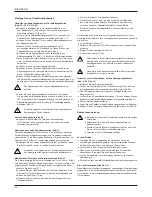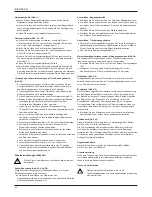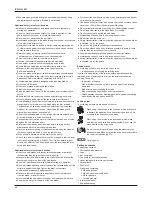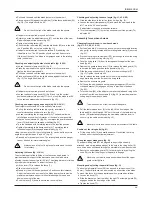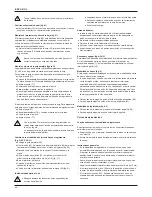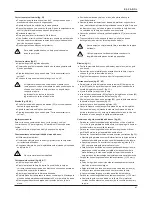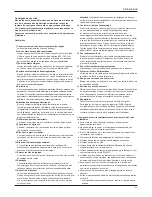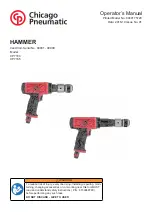
36
E N G L I S H
● Check that the fence is parallel to the blade.
● If adjustment is required, proceed as follows:
● Adjust the fence so that it is parallel to the blade by checking the
distance between the blade and the fence at the front and rear of the
blade. To do so, turn the adjustment screw in the fence support in or
out as necessary.
The default set-up of the fence is to the right-hand side of the blade.
To prepare the fence for use to the left-hand side of the blade,
proceed as follows:
● Loosen the knob (77).
● Pull out the bracket (79) and replace it in the other end.
● Fit the fence to the table.
● Tighten the knob (77).
Use the 11 mm profi le for ripping low workpieces to allow
access between the blade and the fence for the push stick (2).
The rear end of the fence should be level with the front of the
riving knife.
Changing from saw bench to mitre saw mode (fi g. D, E1, E2 & L1)
● Remove the parallel fence (26).
● Turn the wheel (55) of the height adjuster (23) to provide maximum
cutting depth in mitre saw mode (fi g. E2).
● Proceed as described in the section "Turning the sawhead and table
over".
● Slacken the riving knife clamp bolt (75) and remove the riving knife
(16), while holding the blade guard (12) (fi g. L1).
● Lower the blade guard.
● Place the riving knife in its storage position against the saw head.
● Replace the under-table guard (50) (fi g. D).
Instructions for use
● Always observe the safety instructions and applicable
regulations.
●
The attention of UK users is drawn to the "woodworking
machines regulations 1974" and any subsequent amendments.
● Ensure the material to be sawn is fi rmly secured in place.
● Apply only a gentle pressure to the tool and do not exert side
pressure on the saw blade.
● Avoid overloading.
Prior to operation:
● Install the appropriate saw blade. Do not use excessively worn blades.
The maximum rotation speed of the tool must not exceed that of the
saw blade.
● Do not attempt to cut excessively small pieces.
● Allow the blade to cut freely. Do not force.
● Allow the motor to reach full speed before cutting.
● Make sure all locking knobs and clamp handles are tight.
Switching on and off (fi g. A2 & P)
This machine has two independent switching systems. In saw bench
mode, the on/off switch (1) is used. In mitre saw mode, the trigger switch
(15) is used.
Saw bench mode (fi g. P)
The on/off switch used in saw bench mode offers multiple advantages:
– no-volt release function: should the power be shut off for some
reason, the switch has to be deliberately reactivated.
– extra safety: the hinged safety enclosure plate can be locked by
passing a padlock through the centre hasp. The plate also serves as
an "easy to locate" emergency stop button as pressure on the front
of the plate will depress the stop button.
● To switch the machine on, press the green start button (80).
● To switch the machine off, press the red stop button (81).
Mitre saw mode (fi g. A2)
● To switch the machine on, press the trigger switch (15).
● To switch the machine off, release the trigger switch.
Basic saw cuts
Sawing in mitre saw mode
It is dangerous to operate without guarding. Guards must be in position
when sawing.
● Make sure that the under-table guard does not become clogged with
sawdust.
● Always clamp the workpiece when cutting non-ferrous metals.
General handling
– In the mitre saw mode, the sawhead is automatically locked in the
upper "park"-position.
– Squeezing the guard release lever will unlock the sawhead.
Moving the sawhead down retracts the movable lower guard.
– Never seek to prevent the lower guard returning to its park position
when the cut is completed.
– The minimum length of offcut material is 10 mm.
– When cutting short material (min. 190 mm to the left or the right of
the blade), the use of the optional material clamp is recommended.
– When cutting UPVC sections, a supporting piece made out of timber
with a complementary profi le should be placed beneath the material
being cut to provide the correct level of support.
Vertical straight cross cut (fi g. Q)
● Set the rotating table to 0° and make sure that the locating plunger is
engaged.
● Tighten the rotating table clamping knob.
● Place the wood to be cut against the fence. Take hold of the control
handle and press in the guard retraction lever.
● Switch the machine on.
● Allow the blade to cut freely. Do not force.
● After completing the cut, release the switch and wait for the saw
blade to come to a complete stillstand before returning the head to its
upper rest position.
● Release the guard retraction lever.
Do not allow the sawhead to jump back unaided to prevent
damage.
Mitre cuts (fi g. R)
● Set the required mitre angle.
● Ensure that the rotating table clamp is tightly secured.
● Proceed as for a vertical straight cross-cut.
● Prevent the blade cutting the table if the angle is not 45°.
When mitring the end of a piece of wood with a small off-cut,
position the wood to ensure that the off-cut is to the side of
the blade with the greater angle to the fence:
left mitre, off-cut to the right
right mitre, off-cut to the left.
Bevel cuts (fi g. A2 & S)
● Release the bevel clamp handle (22) and tilt the head to the angle
required.
● Tighten the bevel clamp handle.
● Proceed as for a vertical straight cross-cut.
Summary of Contents for DW743
Page 1: ...DW743 ...
Page 3: ...3 3 A2 A1 10 11 8 7 14 13 12 5 6 4 3 2 9 1 21 19 20 18 14 15 16 22 17 ...
Page 4: ...4 4 A4 A5 A3 27 24 25 26 23 22 29 28 34 30 31 33 32 35 ...
Page 5: ...5 5 A8 B A6 A7 29 36 37 38 X ...
Page 6: ...6 6 C1 E1 D C2 E2 47 48 49 18 46 52 51 53 54 50 20 2 55 56 23 ...
Page 8: ...8 8 J2 J1 K1 K2 L1 L2 M N 7 72 74 22 73 75 16 12 76 77 2 20 3 8 mm 62 16 16 25 76 ...
Page 9: ...9 9 O P Q R S T U 77 78 26 79 80 81 V1 82 81 ...
Page 10: ...10 10 V3 W 84 83 85 85 V2 ...
Page 137: ...137 ...
Page 138: ...138 ...
Page 139: ...139 ...





